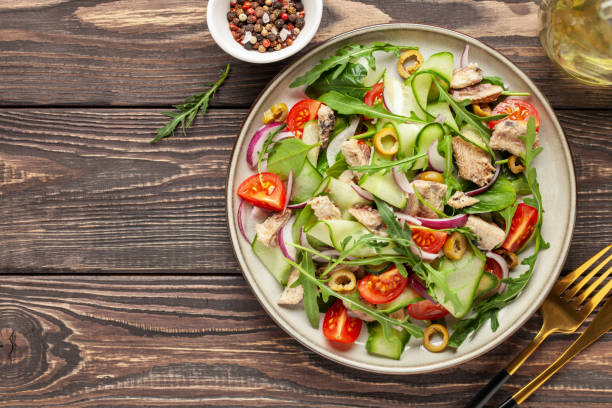
The Mediterranean diet, a culinary celebration of vibrant flavors and wholesome ingredients, is not just a passing food trend but a lifestyle steeped in history, embraced by health enthusiasts, foodies, and cultural explorers alike. Hailing from the Mediterranean basin, this diet comprises an abundance of fresh fruits and vegetables, lean proteins, whole grains, and heart-healthy fats, particularly olive oil, and is often touted for its potential health benefits. Its diverse range of foodstuffs has been associated with a decreased risk of chronic diseases and improved mental health, making it one of the most recommended diets globally.
The lunchtime ritual holds a special place in the Mediterranean dietary tradition. It's typically a hearty meal, celebrated leisurely, often with family or friends, nourishing both the body and the spirit. A Mediterranean lunch is not just about a mid-day energy boost; it is a symphony of flavors, an assortment of vibrant textures, and a testimony to the region's cultural richness.
In this article, we'll introduce you to the world of Mediterranean lunches, exploring the classic ingredients, unraveling the secrets of the Mediterranean palette, and, most importantly, sharing a collection of mouthwatering recipes that you can easily recreate at home. Whether you are a seasoned cook or a beginner in the kitchen, these recipes offer a delightful culinary journey and a nourishing, delicious alternative to the usual lunchtime fare. Get ready to explore, cook, and savor the Mediterranean diet's myriad treasures.
The Staples of a Mediterranean Lunch
A Mediterranean lunch is an edible tapestry, with each ingredient adding to its unique blend of tastes and textures. The essential ingredients found in a Mediterranean lunch highlight the region's agricultural bounty and healthful culinary traditions. Here are the staples that typically make their way to the Mediterranean lunch table:
-
Olive Oil: The lifeblood of Mediterranean cuisine, olive oil is used generously in cooking, dressing salads, and even for drizzling over finished dishes. Rich in monounsaturated fats, it is the primary source of fat in the Mediterranean diet and is associated with heart health.
-
Fruits and Vegetables: Fresh, seasonal fruits and vegetables are central to Mediterranean lunches. They're consumed in abundance in a variety of dishes, from salads and wraps to stews and casseroles.
-
Whole Grains: Whole grains like bulgur, farro, couscous, and whole grain bread are often included in Mediterranean lunches. They provide a satisfying texture and are a good source of fiber and other nutrients.
-
Legumes: Chickpeas, lentils, and other legumes are a common protein source in the Mediterranean diet. They're used in salads, soups, and iconic dishes like hummus and falafel.
-
Fish and Seafood: Owing to the region's geographical positioning, fish and seafood feature prominently in the Mediterranean diet. Grilled, baked, or included in salads, they provide a lean protein source.
-
Nuts and Seeds: Almonds, walnuts, sesame seeds, and other nuts and seeds are often used for added crunch, flavor, and healthy fats.
-
Cheese and Yogurt: Dairy products, particularly cheese and yogurt, are common in Mediterranean lunches. Greek yogurt, feta, mozzarella, and halloumi are a few favorites.
-
Herbs and Spices: Herbs like basil, oregano, rosemary, and spices like cumin, coriander, and saffron give Mediterranean dishes their distinctive flavors.
-
Wine: While not a lunch "staple" per se, a small glass of red wine is considered part of the traditional Mediterranean diet, usually enjoyed with the main meal.
-
Lean Meats: While the diet is largely plant-based, small portions of lean meats, especially poultry, are occasionally included in the Mediterranean lunch.
These ingredients contribute to a culinary philosophy that balances taste and nutrition, making Mediterranean lunches not just a mid-day meal but a wholesome, satisfying experience.
Understanding the Mediterranean Palette
The Mediterranean palette is as diverse and vibrant as the region itself. It is characterized by fresh, aromatic flavors, an abundant use of herbs and spices, and a balance between different tastes – sweet, sour, salty, and umami. Here's a closer look at what defines the flavors of the Mediterranean cuisine:
-
Fresh and Seasonal: Mediterranean cuisine emphasizes fresh, in-season produce, leading to meals that are vibrant, flavorful, and nutritionally rich. The taste of sun-ripened tomatoes, fresh cucumbers, or crisp greens is the hallmark of many Mediterranean dishes.
-
Herbs and Spices: Mediterranean cuisine is renowned for its generous use of herbs and spices, which impart a distinctive taste to the dishes. Commonly used herbs include oregano, rosemary, basil, thyme, and parsley, while popular spices are cumin, coriander, paprika, and saffron. The use of these herbs and spices not only adds flavor but also reduces the need for excess salt, aligning with the diet's heart-healthy focus.
-
The Role of Acidity: Acidic ingredients like lemon juice, wine, and various types of vinegar are frequently used in Mediterranean cuisine. They add brightness to dishes, balance out the richness, and help in marinating meats and preserving vegetables.
-
Umami from Olive Oil and Seafood: Extra virgin olive oil, with its fruity, grassy notes, adds a unique umami taste, as do seafood and cured fish, which are prevalent in Mediterranean coastal areas.
-
Sweetness from Natural Sources: Rather than relying on processed sugars, sweetness in Mediterranean dishes often comes from natural sources like ripe fruits, sweet vegetables, and honey.
-
Heat: While Mediterranean cuisine is not typically associated with spicy heat, certain regions do incorporate a bit of spice into their dishes. For example, harissa—a fiery chili paste—is a staple in North African countries.
Understanding the Mediterranean palette is key to recreating the region's recipes at home. By embracing the harmony of these flavors and learning to balance them in your dishes, you can capture the essence of the Mediterranean diet in your own kitchen.
Recipe Section 1: Mediterranean Sandwiches and Wraps
Sandwiches and wraps are a versatile and popular choice for lunch, and the Mediterranean culinary tradition offers a delightful spin on these classics. Here are two recipes to help you create a nutritious, quick, and tasty Mediterranean-inspired lunch.
Recipe 1.1: Greek Pita Wrap

Ingredients:
- 4 whole wheat pita bread
- 2 boneless chicken breasts
- 1 cup Greek yogurt
- 1 tablespoon lemon juice
- 1 cucumber, diced
- 1 tomato, diced
- 1/2 red onion, thinly sliced
- 1/2 cup feta cheese, crumbled
- 1/4 cup Kalamata olives, pitted and sliced
- 1 teaspoon dried oregano
- Salt and pepper to taste
Instructions:
- Grill the chicken breasts on medium heat, seasoned with salt, pepper, and oregano until fully cooked. Let it rest for a few minutes and then slice into thin strips.
- To prepare the Greek yogurt sauce, mix Greek yogurt with lemon juice, half of the diced cucumber, salt, and pepper.
- To assemble the wrap, open the pita bread and spread a layer of the Greek yogurt sauce. Layer with chicken, the remaining diced cucumber, tomato, onion, feta cheese, and olives.
- Fold the pita bread around the filling, and your Greek Pita Wrap is ready to be enjoyed.
Recipe 1.2: Mediterranean Veggie Sandwich
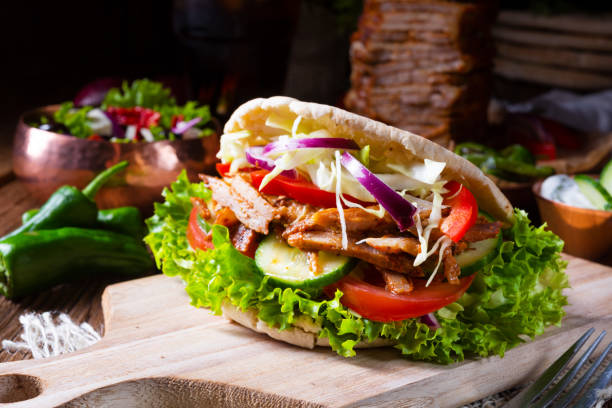
Ingredients:
- 4 slices of whole grain bread
- 1/4 cup hummus
- 1/2 cup fresh spinach leaves
- 1 tomato, sliced
- 1/2 cucumber, sliced
- 1/4 red onion, thinly sliced
- 1/4 cup roasted red bell pepper, sliced
- 1/4 cup feta cheese, crumbled
- Salt and pepper to taste
Instructions:
- Start by spreading the hummus evenly on all the bread slices.
- On two slices, layer the spinach leaves, tomato slices, cucumber slices, red onion, roasted red bell pepper, and crumbled feta cheese. Season with salt and pepper.
- Top with the remaining two slices of bread.
- Cut the sandwich diagonally for easy handling, and your Mediterranean Veggie Sandwich is ready to serve.
These recipes are customizable, allowing you to add or omit ingredients based on personal preferences and dietary restrictions. Enjoy these sandwiches and wraps as a wholesome Mediterranean lunch, packed with a variety of flavors and textures.
Recipe Section 2: Salads and Cold Dishes
Salads and cold dishes are integral to the Mediterranean lunch repertoire, offering refreshing, light, and nutrition-packed options. Here are three simple and delicious recipes to try:
Recipe 2.1: Classic Greek Salad
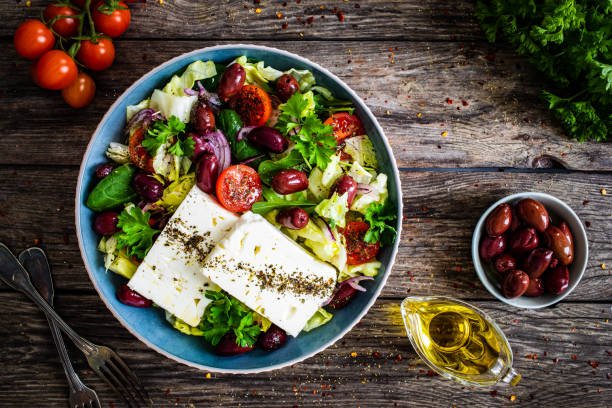
Ingredients:
- 3 tomatoes, cut into wedges
- 1 cucumber, sliced
- 1/2 red onion, thinly sliced
- 1/2 cup Kalamata olives, pitted
- 1 bell pepper, sliced
- 1/2 cup feta cheese, cubed
- 1/4 cup olive oil
- 1 tablespoon red wine vinegar
- 1 teaspoon dried oregano
- Salt and pepper to taste
Instructions:
- In a large bowl, combine tomatoes, cucumber, red onion, olives, and bell pepper.
- Drizzle with olive oil and red wine vinegar, sprinkle with oregano, salt, and pepper, and toss gently to combine.
- Top with feta cheese. Your Classic Greek Salad is ready to serve.
Recipe 2.2: Caprese Salad
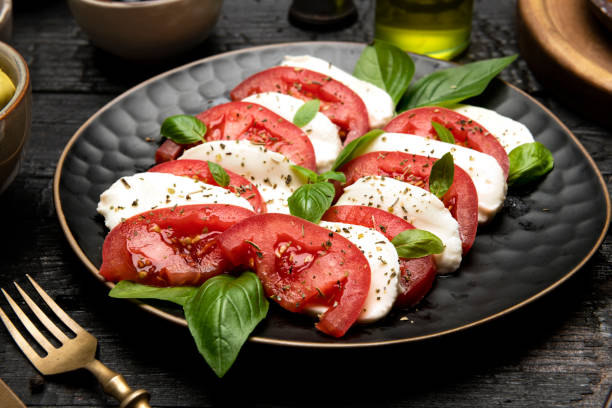
Ingredients:
- 2 ripe tomatoes, sliced
- 200g fresh mozzarella cheese, sliced
- 1 bunch fresh basil leaves
- 1/4 cup extra virgin olive oil
- Salt and pepper to taste
- Balsamic reduction for drizzle (optional)
Instructions:
- Arrange tomato and mozzarella slices on a platter, alternating and overlapping them.
- Tuck whole basil leaves in between the tomato and mozzarella slices.
- Drizzle with extra virgin olive oil, season with salt and pepper, and if desired, drizzle balsamic reduction. Your Caprese Salad is ready to be enjoyed.
Recipe 2.3: Tabbouleh

Ingredients:
- 1/2 cup bulgur wheat
- 4 bunches of fresh parsley, finely chopped
- 1 bunch of fresh mint, finely chopped
- 4 tomatoes, finely diced
- 1 cucumber, finely diced
- 4 spring onions, finely sliced
- Juice of 2 lemons
- 1/3 cup extra virgin olive oil
- Salt and pepper to taste
Instructions:
- Soak bulgur wheat in hot water for about 30 minutes until it's tender. Drain well.
- In a large bowl, mix the soaked and drained bulgur, parsley, mint, tomatoes, cucumber, and spring onions.
- In a separate bowl, whisk together lemon juice, olive oil, salt, and pepper. Pour over the salad and mix well. Your Tabbouleh is ready to serve.
These salads and cold dishes, highlighting fresh ingredients and simple preparation methods, embody the essence of Mediterranean cuisine. They are perfect as stand-alone lunches or as accompaniments to other dishes.
Recipe Section 3: Warm Dishes
Warm Mediterranean dishes offer comfort, depth of flavor, and a delightful culinary experience. Here are two recipes that embody the richness of Mediterranean cuisine.
Recipe 3.1: Chicken Souvlaki
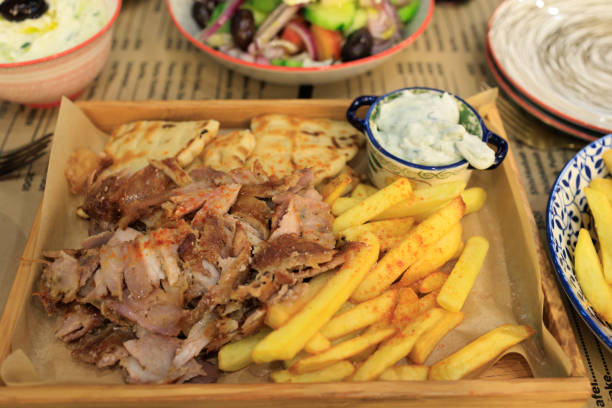
Ingredients:
- 2 boneless chicken breasts, cut into chunks
- 2 cloves garlic, minced
- Juice of 1 lemon
- 2 tablespoons olive oil
- 1 teaspoon dried oregano
- Salt and pepper to taste
- Wooden or metal skewers
- Tzatziki sauce for serving
Instructions:
- In a bowl, mix garlic, lemon juice, olive oil, oregano, salt, and pepper. Add chicken chunks and marinate for at least 2 hours, or overnight if possible.
- Preheat your grill or griddle pan to medium heat.
- Thread the marinated chicken onto skewers. Grill until the chicken is cooked through and has a slight char, about 10-12 minutes, turning occasionally.
- Serve the Chicken Souvlaki with Tzatziki sauce on the side.
Recipe 3.2: Shakshuka
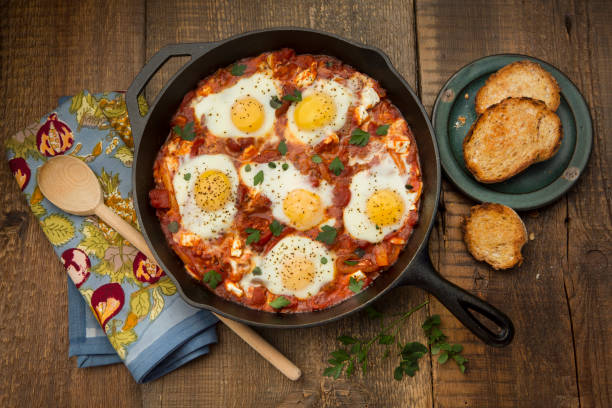
Ingredients:
- 1 tablespoon olive oil
- 1 onion, chopped
- 2 cloves garlic, minced
- 1 bell pepper, chopped
- 4 tomatoes, chopped or 1 can of diced tomatoes
- 1 teaspoon cumin
- 1 teaspoon paprika
- 1/2 teaspoon cayenne pepper (optional)
- Salt and pepper to taste
- 4-6 eggs
- Fresh parsley or cilantro for garnish
Instructions:
- Heat olive oil in a large skillet over medium heat. Add onion, garlic, and bell pepper. Cook until the vegetables are soft.
- Add the tomatoes, cumin, paprika, cayenne pepper (if using), salt, and pepper. Simmer the sauce until tomatoes are soft and the sauce has thickened.
- Make small wells in the sauce and crack the eggs into each well. Cover the skillet and cook for 5-10 minutes, or until the eggs are cooked to your liking.
- Garnish with fresh parsley or cilantro before serving. Your Shakshuka is ready to be enjoyed with some warm crusty bread.
Both of these warm dishes are hearty, flavorful, and exemplify the wholesome simplicity that is characteristic of Mediterranean cuisine. Enjoy them as a special weekend lunch or a satisfying weekday meal.
Tips and Tricks for a Perfect Mediterranean Lunch
Cooking Mediterranean lunches is about more than just following recipes - it's about embracing a style of cooking that prioritizes fresh ingredients, simple preparations, and shared eating. Here are some tips and tricks to help you master the art of Mediterranean lunch:
-
Quality of Ingredients: The Mediterranean diet emphasizes fresh, seasonal, and high-quality ingredients. Make sure your fruits, vegetables, and herbs are fresh, your grains are whole, and your olive oil is extra virgin.
-
Meal Prep: Some components of Mediterranean lunches, like hummus, salad dressings, or marinated proteins, can be prepared ahead of time. This makes assembling lunches during a busy week much easier.
-
Balanced Portions: A Mediterranean lunch typically includes a balance of different food groups. Make sure to include plenty of vegetables, a source of protein (like legumes, fish, or chicken), some whole grains, and a bit of healthy fats like olive oil or nuts.
-
Flavor Layering: The Mediterranean diet is all about layering flavors. Use herbs and spices generously, balance acidity with sweetness, and don't shy away from good quality salts and fresh ground pepper.
-
Cooking Techniques: Grilling, roasting, and sautéing are favored techniques in Mediterranean cooking, helping to bring out the natural flavors of the ingredients. Slow-cooked stews and soups are also common.
-
Make it Colorful: Mediterranean lunches are often visually appealing with a variety of colors from different vegetables and fruits. Aim for a colorful plate for both visual and nutritional variety.
-
Shared Eating: In the Mediterranean region, meals are often a communal affair. If possible, enjoy your Mediterranean lunch with family or friends.
-
Waste Not: Mediterraneans are known for using every part of the food, minimizing waste. Leftover bread can be used in salads like panzanella, vegetable scraps can make a hearty broth, and overripe fruits are perfect for baking or smoothies.
By incorporating these tips and tricks into your cooking routine, you can create a Mediterranean lunch that is not just delicious and healthy, but also truly in line with the Mediterranean lifestyle.
Conclusion
The Mediterranean diet, renowned for its health benefits and delightful flavors, offers a multitude of options when it comes to crafting a nutritious, satisfying lunch. Whether it's vibrant salads, hearty sandwiches, or warm comforting dishes, Mediterranean lunches encompass a variety of ingredients and preparations that cater to diverse tastes and dietary needs.
The essence of this culinary tradition lies in its simplicity, the quality of ingredients, and the harmonious blend of flavors. From the rich, fruity notes of olive oil to the freshness of locally sourced produce, and the unique textures and tastes offered by whole grains and legumes, each element contributes to a well-rounded and pleasurable dining experience.
Mastering Mediterranean lunch recipes isn't just about nourishing the body, but also about celebrating the rich cultural heritage of the Mediterranean region, emphasizing communal eating, and promoting sustainable cooking practices.
In embracing the Mediterranean approach to lunch, you will not only enjoy a midday meal that is packed with flavor but also adopt a lifestyle that is conducive to overall health and wellbeing. So, bring out your apron, gather your ingredients, and let's embark on this culinary journey to the Mediterranean together. Bon Appétit!
Here are some key sources that provide further insight into the Mediterranean diet, its health benefits, and culinary traditions:
-
Willett, W. C., Sacks, F., Trichopoulou, A., Drescher, G., Ferro-Luzzi, A., Helsing, E., & Trichopoulos, D. (1995). Mediterranean diet pyramid: a cultural model for healthy eating. The American journal of clinical nutrition, 61(6), 1402S-1406S.
-
Sofi, F., Macchi, C., Abbate, R., Gensini, G. F., & Casini, A. (2014). Mediterranean diet and health status: an updated meta-analysis and a proposal for a literature-based adherence score. Public health nutrition, 17(12), 2769-2782.
-
Scrinis, G., & Monteiro, C. A. (2018). Ultra-processed foods and the limits of product reformulation. Public Health Nutrition, 21(1), 247-252.
-
Katz, D. L., & Meller, S. (2014). Can we say what diet is best for health?. Annual review of public health, 35, 83-103.
-
Davis, C., Bryan, J., Hodgson, J., & Murphy, K. (2015). Definition of the Mediterranean Diet; A Literature Review. Nutrients, 7(11), 9139–9153.
-
Roden, C. (1996). The Book of Jewish Food: An Odyssey from Samarkand to New York. Knopf.
-
Wolfert, P. (1994). The Cooking of the Eastern Mediterranean: 215 Healthy, Vibrant, and Inspired Recipes. HarperCollins.
For online resources, websites such as BBC Good Food, Epicurious, and The Mediterranean Dish offer a variety of Mediterranean recipes and cooking tips.









